1. Although this rule was made in France, and the instructions are
in French, it includes currency conversion for the pre-decimal British system, and for
Imperial and US units of measure.
2. For those not familiar with it, before decimal currency currency was introduced in
1971, the British system had the pound as the basic unit which was divided in 20 shillings
each of 12 pennies.
3. Despite having the conversion rates for non-metric units of measure, the measuring
scale is calibrated in centimetres. The instructions are in French. It appears therefore
to have been designed for a French person who had to work iwth Imperial or US units of
measure.
4.The rule has the CF and DF scales folded at 360. This is common on commercial rules as
it was normal commercial practice to treat the year as having 360 days for interest
calculations. The cursor only has one hairline whereas other commercial rules have a small
hairline allowing multiplication by 365.
5. The back of the rule has a series of diagrams showing in a simplified way how different
commercial calculations can be performed and tables of conversion factors.
6. The back of the slide has log-log scales for interest calculations and a duplicate C
scale. To use it the slide has to be removed and replaced with the log-log scales showing.

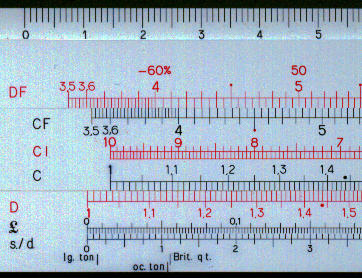
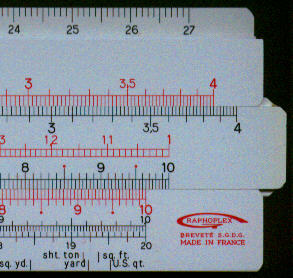
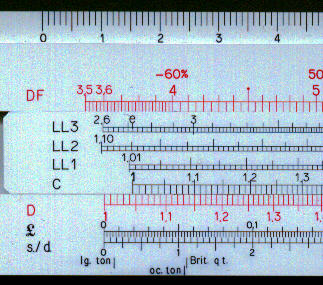
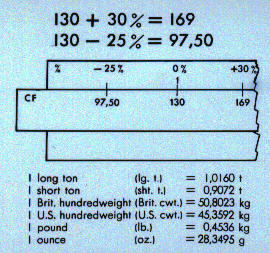
Summary of Instructions
Whilst the rule can be used for basic calculations it is very much aimed at commercial calculations.
 Example: Increase of 30% on 130 francs or 30% off 130 francs.
Example: Increase of 30% on 130 francs or 30% off 130 francs.
1. Align the 130 CF with the 0 DF.
2. Bring the cursor the the (black) +30% mark.
3. Read the answer (169 francs) on the CF scale.
For a reduction use the (red) -30% mark.
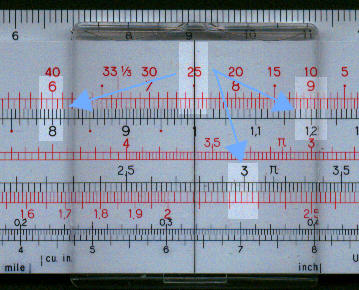 To calculate a percentage increase or decrease for a list of
items, it is better to put the 1 of the CF scale under the appropriate percentage
reduction or increase, and the read the answers on the DF or D against the original value
on the CF or C scale.
To calculate a percentage increase or decrease for a list of
items, it is better to put the 1 of the CF scale under the appropriate percentage
reduction or increase, and the read the answers on the DF or D against the original value
on the CF or C scale.In the example shown the reduction is 25% and the diagram shows
the reduction from 8 francs,6, from 12 francs, 8 and from 3 francs, 2.25.
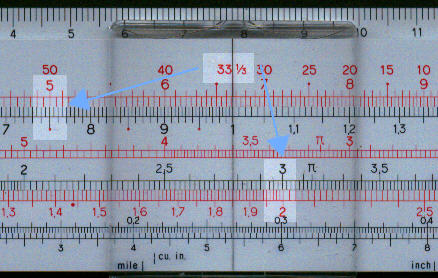 Align the 1 of the CF scale against the appropriate profit
margin. Against the purchase price on the DF or D scale read the sale price on the CF or C
scale.
Align the 1 of the CF scale against the appropriate profit
margin. Against the purchase price on the DF or D scale read the sale price on the CF or C
scale.
In the example shown, for a profit of 30 1/3%, the purchase and sale price would 5 and 7.5 francs or 2 and 3 francs respectively.
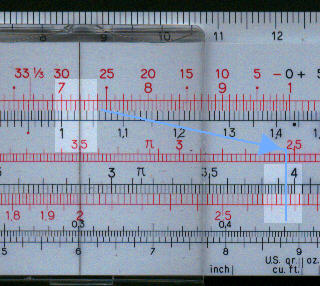 The formula for simple interest is:
The formula for simple interest is:
Interest = Principal * Duration * Rate
The method is to align the interest (% per annum) on the CI scale against the principal on the DF scale. Read the interest on the D scale against the duration in days on the C scale. This calculation makes use of the fact that the scales (CF and DF) are folded (relative to the C and C scales) at 360, the nominal number of days in a year.
The example shows the calculation for a principal of 72 000 France and interest rate of 3.5% per annum. The interest of 2772 is read against the period of 396 days.
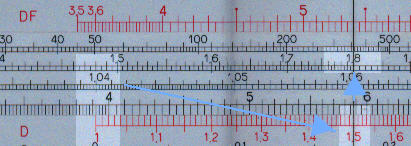 The formula is:
The formula is:
Payment = Capital * ( 1 + Rate / 100) Duration (years)
The calculation has to be performed in two stages. First you calculate:
x = ( 1 + Rate / 100) Duration (years)
Then you calculate:
Payment = Capital * x.
To perform the first calculation it is necessary to remove the slide and turn it round. You the set the the value of "1+rate/100" on the appropriate LL scale (usually the one labelled LL1 on this scale) against the 1 on the D scale. The you read the value of x on the appropriate LL scale against the number of years on the D scale.
For example what would be total payment on a mortgage of 1 200 00 France at 4% for 15 years. Set the 1.04 against the 1 on the D scale and read the value of x, 1.80, on the LL2 scale. Note that we have got the answer on the LL2 scale. If the period had been 1.5 years we would have got the answer on the LL1 scale.
Next multiply 1 200 000 by 1.8 and get the answer 2 160 000 francs.
 The basic,
pre-decimal currency, unit of currency was the pound, this was divided into 20 shillings
each of which had twelve pence. The penny itself was could be divided into half-pennies,
written ha'penny, and farthings, a quarter of a penny although this was no longer used by
the time of conversion to decimal currency in 1971. The advantage of the duodecimal. (i.e.
12 based) system as opposed to the decimal (10 based system) was that many more factors
were possible. For example 12 has the factors 2, 3, 4 and 6 whereas 10 has only two
factors, 2 and 5.
The basic,
pre-decimal currency, unit of currency was the pound, this was divided into 20 shillings
each of which had twelve pence. The penny itself was could be divided into half-pennies,
written ha'penny, and farthings, a quarter of a penny although this was no longer used by
the time of conversion to decimal currency in 1971. The advantage of the duodecimal. (i.e.
12 based) system as opposed to the decimal (10 based system) was that many more factors
were possible. For example 12 has the factors 2, 3, 4 and 6 whereas 10 has only two
factors, 2 and 5.
The example on the right shows the conversion from 11s 6d to decimal £ 0.575.
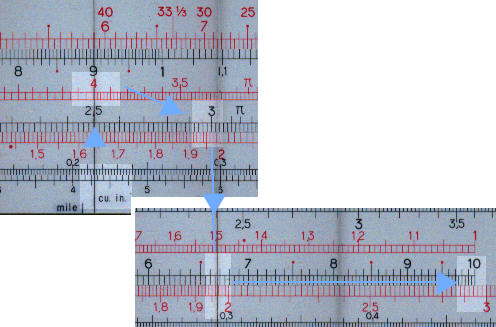 Along the bottom of the rule there are a number of gauge marks
for conversion factors from/to metric and U.S. and Imperial units. Whilst in many cases
the Imperial (i.e. British) and the U.S. systems are the same for other units, for example
the hundredweight (abbreviated cwt) this is not the case.
Along the bottom of the rule there are a number of gauge marks
for conversion factors from/to metric and U.S. and Imperial units. Whilst in many cases
the Imperial (i.e. British) and the U.S. systems are the same for other units, for example
the hundredweight (abbreviated cwt) this is not the case.
The instructions also show a quick and ingenious way of doing the calculation in one set of units and getting the answer in another.
The example shows 4" * 3" * 1.5" with the answers in cm3 .
1. Set the cursor line to the cu.in mark.
2. Align 4 on the CI scale with the cursor.
3. Align the cursor with 3 on the C scale.
4. Align 1.5 on the CI scale with the cursor.
5. Read the answer 295 cm3 against the on the D scale against the 10 on the C
scale.